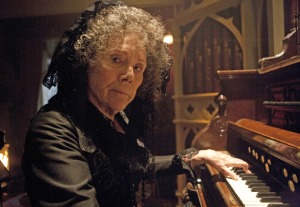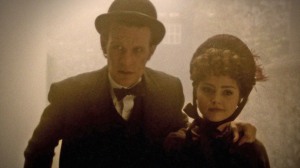jason stives sees the horror …
Warning: If you haven’t watched tonight’s episode yet, refrain from the massive spoilers ahead.
As I learned after last week’s episode, sometimes you can love an episode of Doctor Who a lot in spite of some more than obvious plot holes that should completely derail the narrative. If you cling to an idea and wave off anything else it’s easy to enjoy something at face value in spite of its overall structure issues but not every episode has this benefit. Sometimes a story has a great idea that is poorly executed but runs much smoother than one with an amazing idea that is fully realized to its potential but lacks logic. “The Crimson Horror” is an example of just that; a story that has a lot working for it in concept but unfortunately falls short due to a rushed plot, an overdose of hokey humor and fluctuating tone that tries to encompass a variety of genres for the viewings to enjoy.
Set in 1893, we return to Victorian England where we encounter our old friends Madame Vastra, Jenny, and Strax, who are sent to Yorkshire to investigate the strange happenings of Sweetville, a factory community run by the mysterious Mrs. Gillyflower (Diana Rigg). Accompanied by her blind daughter (Rachael Sterling), Ada, she only takes the strongest and healthiest individuals into her community but when certain people start showing up in the morgue bright red, dubbed “the crimson horror,” the implications of Sweetville become a point of interest to the people of the North. What is the crimson horror and why is the Doctor showing up as the final image seen by one of the victims?
The first thing to point out is for a good quarter of the episode we are treated to a fairly Doctor-lite encounter as Jenny becomes lead detective infiltrating the walls of Sweetville. Caitrin Stewart is wonderful here and it’s great seeing her take on more than she has before but ultimately if it wasn’t for the plot involving the Doctor being captured by Mrs. Gillyflower there would be no use for our new favorite detective agency. Sure, their presence is more than welcomed here but they are so minor to the plot that these three could’ve been any side character. Vastra is the least utilized and Strax, well, it’s Strax, but he gets his fair share of entertaining one liners and even a bit of action back in his traditional Sontaran suit by episode’s end. Still this is partly where we find the story begin to become unraveled because both established and new supporting roles are underutilized to their fullest extent.
For all the hype that was built around her casting there was something missing from the presence of Dame Diana Rigg as Mrs. Gillyflower. I don’t think its age by any means (I’ve seen her in recent roles that say otherwise) but between being an underdeveloped character and having the over the top nature of a mustache twirling baddie her contribution feels stale and unwanted. In contrast, her on and off screen daughter Rachael Sterling works very well as Ada, and this comes down to a massive amount of sympathy that is thrown into her performance. I found myself really having my heart strings pulled at Ada’s breakdown when she realized her “monster” had been taken away from her but overjoyed when the Doctor later comforted her at her lowest point. There isn’t much to be felt in the relationship between Ada and her mother (strange, I know) but it’s not for a lack of trying; there was just nothing in writing that is given great nurturing in the performances. The meat of the show’s developments lied in the tone and the setting alone.
If “Cold War” was Mark Gatiss showing how well he knows classic Who then this week was an all out glorification of his love of horror. So it’s no surprise that tone wise this is a complete send up to Hammer Horror films and as someone who grew up with those particular movies Gatiss nails it. Part of me was waiting for a Peter Cushing look alike or some buxom goddess in a low cut dress to figure into the plot but sadly that never came to fruition. This all fits in with the northern setting and especially with the creepy Willy Wonka like feel of Sweetville which plays like a demented child’s dream and rightfully so. There were more than a share of frights this week and mixed with the dark humor that was glimpsed in flashes it helped ease out of some terrifying situations but it’s said humor that feels the least at home this week.
The humor itself was a mixed bag for this particular story; sometimes it worked and sometimes it fell flat. There is nothing wrong with humor in Doctor Who by any means if any one writer is going to use that the full extent of the law let it be Gatiss whose background in comedy makes him more than qualified. The humor feels like a cross between the legendary Carry On British film series and Gatiss’ own work in The League of Gentlemen but it doesn’t always mesh well considering the scatter brain tone of the story. Indeed, this is definitely one of the more unique episodes the show has been producing lately and credit has to be given to the smaller things of this story that are attempted. Between starting the episode with no Doctor at all (nothing new in fairness) coupled with the unique monochrome flashbacks of the Doctor and Clara leading up to their arrival. Not that there is much to talk about on their end but Smith and Coleman once again display a dynamic chemistry that as each story has passed seems to be setting in a lot easier. It helped that this week was light on continuity and pushing the story arc save for the incredibly forced ending so we just got the Doctor and his companion like old times in an old timey setting no less. The show continues to be a little more daring in some of its techniques and styles overall and considering how crowded this story was with ideas this was a perfect place to test the waters.
Still, style isn’t everything and the essence of the overall plot involving the poisoning of humanity with a prehistoric venom isn’t greatly explained or executed. From the outset it was obvious whoever Mr. Sweets was it would have some grizzly nature to it but the parasite that he was revealed to be, with his creepy infant alien look was a bit silly and just really dumb at best. I was more than glad to watch Ada smash it to bits with her cane. This is one of many things that just fall short of working in “The Crimson Horror” and the tone keeps shifting on what it wants to be. Part of me believes that Gatiss really wanted to showcase the various styles of Doctor Who through the years here and it does indeed feel likes parts of the classic era mixed in with the modern but it never stays firmly in place and feels bizarre at best.
In what has turned out to be the 100th episode of new Who, “The Crimson Horror” is but another example of how we take our cream with our coffee (or tea for those reading across the pond) and how even a lack of cohesiveness at times still allows an episode to shine with potential and maybe even a chance to rewatch it once in awhile. “The Crimson Horror” was by no means a bad episode of Doctor Who, on the contrary, if the story had been given a little more time to breathe with its intent it probably would’ve been four weeks in a row for me of solidly consistent stories. Despite an excellent setting, some strong chemistry from our leads, and some good chills here and there it fell short of being a highlight to this rather scatterbrain season but it’s definitely one people will talk about in retrospect when it’s said and done.
Rating: 6.5 out of 10 (Good, not Great)
All Photos Credit: BBC America






